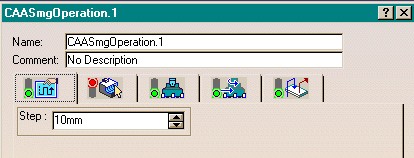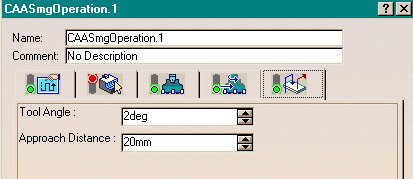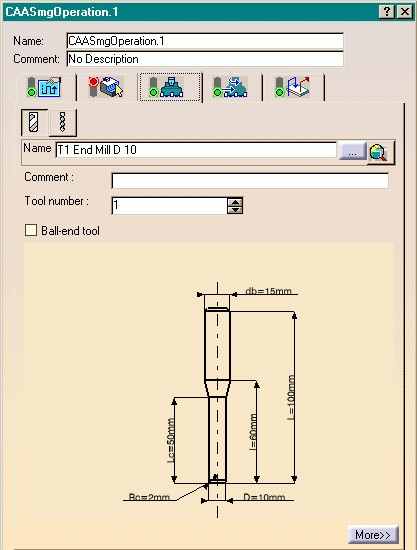Machining |
3 Axis Surface Machining |
Customizing the Surface Machining Operation EditorCustomize default operation tab pages |
| Use Case | ||
AbstractThis article discusses the CAASmiUserOperationUI use case. It explains how to customize strategy, tool and macros tab pages of the surface machining operation editor. This paper accompanies the Surface Machining Operation Sample [1],
but it can be used for any Manufacturing Activities. |
When a surface machining operation is edited by double clicking or through its contextual menu, a default dialog box is displayed.
This use case is intended to help you to customize some of the tab pages of this panel. This involves the following:
[Top]
CAASmiUserOperationUI is a use case of the CAASurfaceMachiningItf.edu framework that illustrates Surface Machining capabilities. It is a part of the sample described in the technical article [1].
[Top]
This use case customizes three tab pages of the CAASmgOperation editing panel:



[Top]
This use case is a part of Surface Machining Operation Sample [1]. You should build all the modules of this sample at a time to be able to launch it [2].
Don't forget to edit the interface dictionary located in:
| Windows | InstallRootDirectory\CAASurfaceMachiningItf.edu\CNext\code\dictionary\ |
| Unix | InstallRootDirectory/CAASurfaceMachiningItf.edu/CNext/code/dictionary/ |
where InstallRootDirectory is the directory where the CAA CD-ROM
is installed, and uncomment the appropriate lines by removing the '#' character.
[Top]
This use case is made of source files located in the CAASmiUserOperationUI.m module of the CAASurfaceMachiningItf.edu framework:
| Windows | InstallRootDirectory\CAASurfaceMachiningItf.edu\CAASmiUserOperationUI.m |
| Unix | InstallRootDirectory/CAASurfaceMachiningItf.edu/CAASmiUserOperationUI.m |
where InstallRootDirectory is the directory where the CAA CD-ROM
is installed.
[Top]
There are three logical steps in CAASmiUserOperationUI:
We now comment each of those sections by looking at the code.
[Top]
To overload the strategy tab page, we should create an extension class that will implement CATIMfgStrategyActivity
... // Tie the implementation to its interface #include "TIE_CATIMfgStrategyActivity.h" TIE_CATIMfgStrategyActivity( CAAESmiUserOperationStrategyEditor); ... |
In GetMainPanelEditor, we create a frame that contains the frame-editor of our strategy parameter "CAAStep"
...
oFrame = new CATDlgFrame (iFather, "StrategyFrame", CATDlgGridLayout|CATDlgFraNoTitle);
if (oFrame)
{
// Gets strategy parameter
CATIMfgActivityParameters * pActivityParameters = NULL;
oRC = QueryInterface(IID_CATIMfgActivityParameters, (void**) &pActivityParameters);
if (SUCCEEDED(oRC))
{
CATBaseUnknown_var spBaseParm = NULL_var;
oRC = pActivityParameters->FindElement("CAAStep",spBaseParm);
CATICkeParamFrame_var spParamFrame (spBaseParm);
if (!!spParamFrame)
{
...
// Creates a frame-editor linked to the parameter
CATDlgFrame *pDlgFrame = spParamFrame->GetInPanelEdition(NULL_var,oFrame,CATCkeWithSpinner|CATCkeNoLabel);
if (pDlgFrame)
pDlgFrame->SetGridConstraints( 0, 1, 1, 1, CATGRID_4SIDES);
...
}
...
|
[Top]
To overload the macros tab page, we should create an extension class that will implement CATIMacroEditorActivity
... // Tie the implementation to its interface #include "TIE_CATIMfgMacroEditorActivity.h" TIE_CATIMfgMacroEditorActivity( CAAESmiUserOperationMacroEditor); ... |
In GetMainPanelEditor, we create a frame that contains frame-editors of our macros parameters "CAAToolAngle" and "CAAApproachDistance"
...
oFrame = new CATDlgFrame (iFather, "MacrosFrame", CATDlgGridLayout|CATDlgFraNoTitle);
if (oFrame)
{
...
// CAAToolAngle
oRC = pActivityParameters->FindElement("CAAToolAngle",spBaseParm);
CATICkeParamFrame_var spParamFrame (spBaseParm);
if (!!spParamFrame)
{
...
// Creates a frame-editor linked to the parameter
CATDlgFrame *pDlgFrame = spParamFrame ->GetInPanelEdition(NULL_var, oFrame ,CATCkeWithSpinner|CATCkeNoLabel);
if (pDlgFrame)
pDlgFrame->SetGridConstraints( 0, 1, 1, 1, CATGRID_4SIDES);
}
//CAAApproachDistance
oRC = pActivityParameters->FindElement("CAAApproachDistance",spBaseParm);
spParamFrame = spBaseParm;
if (!!spParamFrame)
{
...
// Creates a frame-editor linked to the parameter
CATDlgFrame *pDlgFrame = spParamFrame ->GetInPanelEdition(NULL_var, oFrame ,CATCkeWithSpinner|CATCkeNoLabel);
if (pDlgFrame)
pDlgFrame->SetGridConstraints( 1, 1, 1, 1, CATGRID_4SIDES);
}
...
}
...
|
[Top]
To customize tool tab page, we should create an extension class that will implement CATIMfgToolActivity. This interface offers services to manage allowed and default tools. If you like to overload the whole tab page, see the CAAMaiToolEditionCustomization use case [3].
... #include "TIE_CATIMfgToolActivity.h" TIE_CATIMfgToolActivity( CAAESmiUserOperationToolEditor); ... |
In GetAuthorizedToolTypeList, we set the types of allowed tools of our operation
HRESULT CAAESmiUserOperationToolEditor::GetAuthorizedToolTypeList (CATListOfCATUnicodeString & oToolTypeList)
{
// Allowed Tools
oToolTypeList.Append(CATEMfgEndMillTool);
oToolTypeList.Append(CATEMfgDrillTool);
return S_OK;
}
|
In CreateDefaultTool, we set the default tool of our operation
HRESULT CAAESmiUserOperationToolEditor::CreateDefaultTool (CATBaseUnknown_var & oTool)
{
...
// Retrieves Resource Factory
if (!!spResourceContainer)
{
CATIMfgResourceFactory * pResourceFactory = NULL;
oRC = spResourceContainer->QueryInterface(IID_CATIMfgResourceFactory, (void**) &pResourceFactory);
if (SUCCEEDED(oRC))
{
// Creates Default Tool
CATUnicodeString ToolTypeToCreate = MfgEndMillTool;
oTool = pResourceFactory->CreateResource(ToolTypeToCreate);
pResourceFactory->Release();
pResourceFactory = NULL;
// Defines a Default tool for our user operation
if(!!oTool)
{
CATIMfgTool * pMfgTool = NULL;
oRC = oTool->QueryInterface(IID_CATIMfgTool, (void**) &pMfgTool);
if (SUCCEEDED(oRC))
{
pMfgTool->SetDefaultValues();
pMfgTool->SetDefaultName();
pMfgTool->Release();
pMfgTool = NULL;
}
CATIMfgActivity * pActivity = NULL;
oRC = QueryInterface(IID_CATIMfgActivity, (void**) &pActivity);
if (SUCCEEDED(oRC))
{
pActivity->SetDefaultTool(oTool);
pActivity->Release();
pActivity = NULL;
}
}
}
}
...
}
|
[Top]
This article provides an example on how to customize strategy, tool and macros tab pages of the editing dialog panel of a surface machining operation. How to customize geometry tab page is described in the next use cases [4] & [5].
[Top]
| Version: 1 [Mar 2002] | Document created |
| [Top] | |
Copyright © 2002, Dassault Systèmes. All rights reserved.